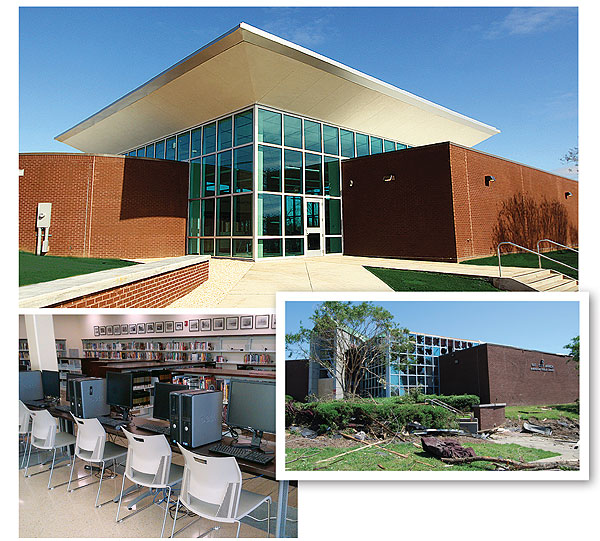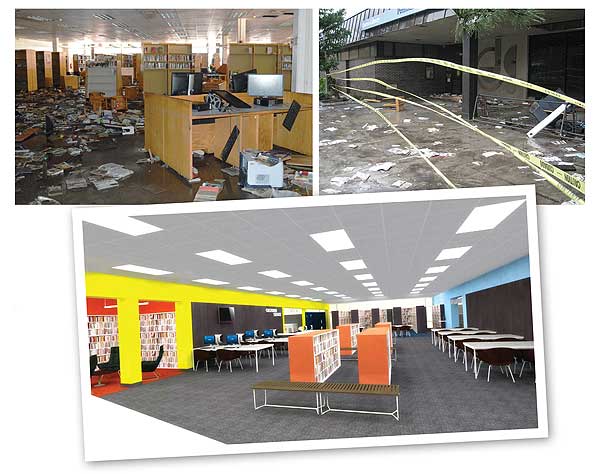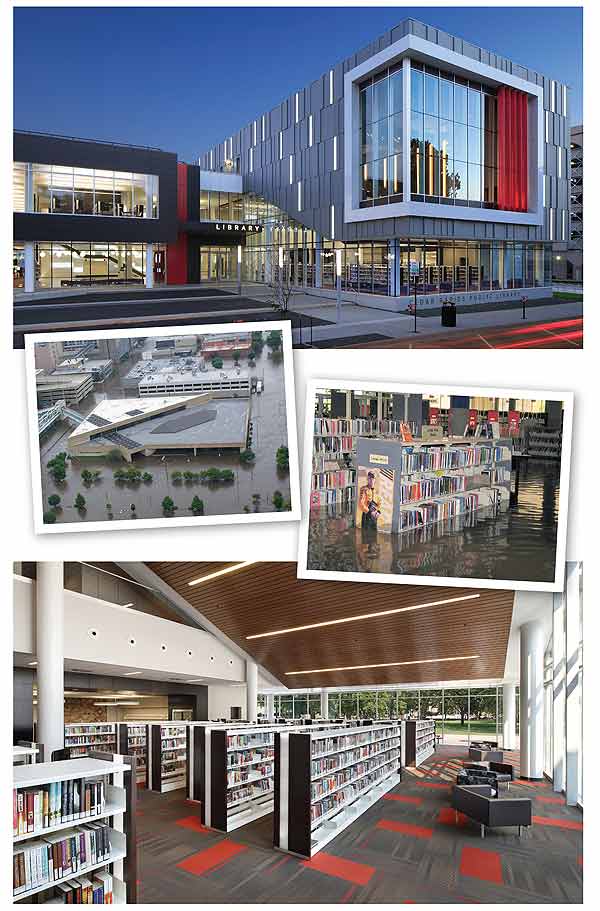The Comeback Kids | Library by Design, Fall 2014

When the Cedar River breached its banks in 2008 to flood downtown Cedar Rapids, IA, the entire first floor of the two-story Cedar Rapids Public Library (CRPL) Downtown Branch drowned in the deluge.
The natural disaster occurred at the start of the recession, causing the library’s Board of Trustees to question whether it could find the funds to relocate and replace the building, says Susan Corrigan, a library board member. “You kind of forget what the dark days looked like, but we had some really dark days,” says Corrigan. However, ultimately the board was successful. Corrigan headed up the Building Committee and served as board president while the new facility was constructed.
The new $45 million, 94,000 square foot Downtown Branch opened in August 2013, sitting 28 inches above the record-breaking high-water mark. The replacement building includes expanded space for children and teens and offers flexible meeting and gathering space, a café, a green roof, and an auditorium, along with views of the nearby park and cityscape. It’s certified U.S. Green Building Council Leadership in Energy & Environmental Design (LEED) Platinum and has won at least five architecture awards, according to designers OPN Architects.
What kept the board and library leaders moving forward was a dream of changing how library service was delivered to patrons. “We didn’t lose sight of that vision,” Corrigan says.
Vision and determination are two of the qualities that various library leaders and architects around the country used to rebuild libraries demolished in a variety of natural disasters. A number of these libraries have emerged better connected to their communities and stronger than before.
More than seven years after Hurricane Katrina devastated the Southeastern United States in 2005, the New Orleans Regional Library reopened five buildings after operating out of trailers for years.
In New York City, Brooklyn Public Library’s Coney Island Library and Queens Library (QL) at Peninsula were flooded in 2012 when Superstorm Sandy battered the East Coast. The Peninsula and Coney Island libraries each used the rebuilding efforts to find opportunities to improve the facilities’ ability to act as a gathering place and technology hub.
To the south, a tornado tore through Birmingham, AL, in April 2011, peeling the roof off the Birmingham Public Library’s (BPL) Pratt City Branch. The library reopened this past February and renewed its place as a community core. It has attracted 100 new cardholders each month from February to July, says Deborah Drake Blackmon, BPL’s Pratt City Branch manager. “There’s been a significant transformation since the tornado. It has really increased what the library means to Pratt City and to the city of Birmingham,” she says.

STANDING STRONGER Birmingham’s Pratt City Branch came back from a 2011 tornado (inset) with an aerodynamic roofline built to channel winds and safeguard against future damage. Inside (bottom l.), computer stations offer expanded capability after a tornado tore the roof off the building. Top photo by Chanda Temple/Birmingham PL; bottom photo by Melinda Shelton/Birmingham PL
Raising resistance
When natural disasters occur, the Federal Emergency Management Agency (FEMA) provides funding to help government agencies restore or replace buildings. However, that money doesn’t cover all costs, and it comes with requirements to improve a structure’s ability to withstand future disasters. In some cases, libraries like Cedar Rapid’s Downtown Branch relocate to higher ground, including adding fill to slope the site higher. “We built the library up as far as we could but still have it be walkable and wheelchair accessible,” Corrigan says.
To make the Queens Library at Peninsula more storm- and flood-resilient, a knee-high wall was added, says Queens Library VP over capital and facilities management Frank Genese. The wall should allow a couple of feet of water to surround the library without breaking the windows, which smashed during the recent storm, letting in the floodwaters, he says.
Both the Peninsula Library and the Coney Island Library will use durable flooring and furnishings that can be cleaned easily after a flood.
As with many libraries in flood-prone areas, the Peninsula, Cedar Rapids, and Coney Island buildings moved expensive mechanical equipment to the roof. “We did take the opportunity to rethink this space and what we could do if we ever had a catastrophe like this again,” says Brett Robinson, Brooklyn PL’s executive vice president of finance and administration.
At Birmingham’s Pratt City branch, the $1.8 million reconstruction project included a new aerodynamic roof that channels a tornado’s swirling winds, says Director Renee Blalock, who retires this September. A sophisticated drainage system on the roof, which feeds runoff into a sculpture on the side of the building, will prevent sagging under the weight of torrential rains. Tornado-resistant glass fills the windows. The staff room and the women’s restroom can serve as a tornado shelter for up to 30 people. “The storm shelter is just in case. Our hope is that we would always close early,” Blalock says. The library did exactly that during the 2011 tornado, closing five hours before it struck.

STORMY WEATHER Furnishings, books, DVDs, CDs, and equipment at the Queens Library at Peninsula in Rockaway, NY, drowned in the 2012 deluge that was Superstorm Sandy as debris littered the street out front. The architect’s rendering (bottom) of the future restored adult reading area features more computers and places for patrons to gather. Photos courtesy of Queens Library
Making room for community
During reconstruction after a natural disaster, library leaders tend to focus on relocating irreplaceable items to safer locations and/or expanding the library’s function as a community gathering space, says Beth Joy Patin, a doctoral candidate at University of Washington’s (UW) Information School (iSchool) who studies the role of librarians and libraries during disasters. “We’re seeing more collaborative spaces, seeing more technology hubs, more computers and places where people can bring their own (computers),” Patin says. That makes sense, given that these evolving roles for the public library may have been less of a priority when legacy spaces were originally designed. In addition, disasters that don’t directly impact the library building may bring community members out in force to use library resources in their own recovery.
Expanding public space when restoring a building may mean giving up something. To add more computers in the Coney Island branch, where a third of residents lack high-speed access at home, the space for the collection dropped by 20 percent, says George Joseph, Brooklyn PL deputy head of capital planning. “We also changed to a much more open layout and offer more public meeting space than there had been previously,” Joseph says.
Other libraries automated some circulation functions and reduced staff work areas to gain room for meeting rooms, technology centers, and teen zones or just to gather. Some libraries tore down walls or reduced the circulation footprint.
Coney Island Library and Peninsula Library were not the only structures to need rebuilding after Sandy. Of the six Brooklyn branches damaged by Sandy, the Coney Island Library was among the worst hit, inundated with five feet of water. Peninsula was the only one of the four Queens Libraries to undergo transformation, rather than being restored to its prestorm state. (The others had been recently upgraded before Sandy hit.)
For Peninsula, which is scheduled to open in early 2015, library leaders decided the estimated $2.4 million renovation should include adding an automated book return and materials sorter, as well as moving two walls to add a classroom dedicated to adult learning. Teens at Peninsula will discover a big-screen television, a green screen, and equipment for computer gaming all in a spacious 1,000 square foot area devoted to them. An open layout combined with a bright palette of blues, oranges, and yellows, along with wood, will provide patrons seeking escape from cramped apartments the space to sprawl, says Andrew Gale of IDG Architects, the firm that redesigned Peninsula. “We want it to be a neighborhood beacon,” QL’s Genese says.
In Cedar Rapids Downtown Branch, natural light immerses the building, offering welcoming, formal, and impromptu meeting spots. “We have a lot of places in the library where you can go and have your space, a book club, or a little nook to hang out in and read, places that Bob [Pasicznyuk, former director] says that they can celebrate life in,” Corrigan says.

A RISING TIDE The new downtown branch of the Cedar Rapids Public Library (top) reopened in August 2013 in a new location after the record-breaking 2008 flood that swamped the city’s downtown (middle l.). The adult fiction collection and cozy spots for reading and gathering (bottom) are a far cry from the water-logged stacks (middle r.). Cedar Rapids renovation photos by Wayne Johnson, Main Street Studio. Flood photos by Tam Glise/CRPL.
Celebrating their roots
Both Brooklyn’s Coney Island Library and Birmingham’s Pratt City Branch tapped into the history of their respective communities for the rebuilds.
When the Pratt City Branch reopened in February, patrons discovered many of their suggestions had been implemented, including additional meeting rooms with presentation equipment, a business center, and increased wireless and technology capacity, as well as expanded space for children and teens, Blackmon says. The community’s coal mining history is showcased throughout the branch in cabinets and walls and even underfoot. A terrazzo floor marks major landmarks on the city’s walking tour and provides spontaneous local history and geography lessons. “The children think it’s like hopscotch when they see these numbers and different shapes,” Blackmon says. “We have to explain [that] these are where these places are in Pratt City, and this is where you are.”
As part of the post-Sandy restoration effort, architects and library staff working on the $2.7 million Coney Island Library reconstruction salvaged pieces of the hurricane-destroyed historic boardwalk, Steeplechase Pier, and incorporated the wooden planks into the building’s ceiling, says Salvatore Coco, a partner at Beatty Harvey Coco Architects, which did the renovation. Architects also delved into Brooklyn PL’s archives to find historic images of the boardwalk and its attractions, including the iconic parachute jump. These images became a wraparound mural-sized collage covering the interior walls. Walking into the library resembles a stroll into the boardwalk’s history. “What we were looking for was more of a retail aesthetic for the library, to make it more appealing to stop in and browse, to make it a place that you really felt invited to come into, to know it was a public space and to know it was open to everyone in the community,” Coco says.

BUILDING IN HISTORY Mural-sized historic photos of iconic boardwalk amusements and salvaged wooden decking tie Brooklyn PL’s Coney Island Library to its famous beachfront attractions, a mere two blocks away. The texture of the vinyl floor reflects the grain in the ceiling. Photo by Emily Andrews
Landing on the fast track
As in the case of the Queens Library at Peninsula, which needed upgrading before Sandy hit, a natural disaster can also accelerate priorities already in place. Such is the case at California State University–Fullerton’s Paulina June & George Pollak Library, where a magnitude 5.1 quake this past March destroyed the ceiling on four floors in the library’s south tower. Repairs are estimated at around $7 million, and the university has applied for both state and federal disaster aid, as well as exploring other funding options such as a revenue bond, says Fullerton’s provost and vice president for academic affairs José L. Cruz.
The damage accelerated the university’s efforts in the Cal State systemwide initiative called the Libraries of the Future, Cruz says. As part of the initiative, librarians must consider the use of tangible and electronic collections in future and determine where to house collections both physically and virtually before repairs are planned. A consultant specializing in library safety will help evaluate the situation. Any decisions must be coordinated with the libraries as the five other Cal State campuses in the Los Angeles basin because the six institutions share their collections, as well as with the Fullerton Faculty Senate. Meanwhile, the library has moved programs and services to its northern tower, and upon request staff fetch items from the damaged sections, which are barred to the public. “The main problem we have right now is safety,” Cruz says.
Temporary testing
Leadership at CRPL decided the flooding provided an opportunity to transform library service. First, the board hired Bob Pasicznyuk as director, who envisioned the library having a flexible design that can respond quickly to patron needs. (He has since accepted the directorship at Douglas County Libraries, CO.)
To put his vision into place, Pasicznyuk and the CRPL staff used the temporary library as a testing ground for his ideas, says Mindy Sorg, lead interior designer at OPN Architects, the firm that designed the new downtown branch. There, staff perfected the radio-frequency identification (RFID) tags and automated check-in and replaced the large circulation desk with smaller self-check kiosks. Pasicznyuk wanted library staff on the floor working side by side with the public. Once tested, incorporating those improvements into the new building went smoothly, Corrigan says. For their efforts, members of CRPL’s management team were named LJ’s Librarian of the Year in 2009.
Pasicznyuk also wanted the bulk of the meeting spaces on the second floor, forcing visitors to walk through the library to attend events in the auditorium or on the roof, hopefully enticing them to return, says Bradd Brown, a principal at OPN Architects. In the first ten months since the building opened, the green roof hosted 19 events and eight weddings. As well, the library staff have kept a keen eye on how people use the space and made suggestions, such as moving furnishings and adding electrical outlets, Corrigan says. “Flexibility in our space was very important. As the world changes, we really wanted to,” Corrigan says.
Lessons to share
The leaders of Queens, Brooklyn, Birmingham, and Cedar Rapids libraries say partnerships with other government agencies, libraries, area businesses, and the community proved invaluable in rebuilding and offering service to patrons during and following the disaster. Municipal and state governments helped with paperwork and with preparing for the disaster before it occurred. Public-private partnerships resulted in grants and donations.
When CRPL’s Downtown Branch flooded, its Iowa sister library systems in Hiawatha and Marion offered service to patrons until a temporary library opened. OPN Architects was already under contract to upgrade the flooded branch, and interior designer Sorg worked the phones asking vendors to donate flooring and furnishings for the temporary facility.
Libraries can apply for federal grants to create disaster response plans because FEMA in 2011 designated libraries as critical infrastructure, says UW iSchool’s Patin. This sort of preparation can makes a difference in how quickly libraries respond. After Katrina, librarians in Texas brought laptops to the Houston Astrodome to help people who lost their homes with FEMA paperwork and contacting loved ones, Patin says.
In New York City, libraries coordinate with the New York City Office of Emergency Management. Following Sandy, the Queens Library rolled into action, sending book buses to take the place of the closed facilities. They provided printouts of information on emergency services, FEMA, and the upcoming election. “We’re the first there, and people were so excited to see the library there,” says QL’s Genese.
“Be ready to mobilize if you’re a library,” Genese says. “People will be looking to you for help, and if you’re not prepared to do that, it’s going to be a problem.”
Cedar Rapids Downtown Branch
System Cedar Rapids Public Library, IA Total replacement cost $45 million Construction $24.1 million Contents $8.5 million Land $7.5 million Professional fees and permits $500,000 Square feet 94,000 Funding Federal, state, and local money, including state economic development grants and fundraising efforts Architect OPN Architects Contractor Knutson Construction Company of Iowa City Damage Flooded June 13, 2008, when the Cedar River breached its banks, rising nine feet above the 500-year floodplain Reopened August 24, 2013Peninsula Library
System Queens Library, NY Total restoration cost $2.4 million Construction $1.7 million Square feet 12,750 Funding FEMA, insurance, and grants Architect IDG Architects Contractor Under consideration at press time Damage Flooded in Superstorm Sandy 2012 Scheduled for reopening Early 2015Paulina June & George Pollak Library
System California State University, Fullerton Estimated repair cost $7 million Funding Sources being identified Architect To be determined Contractor To be determined Damage Ceiling in the library’s southern tower destroyed in March 28, 2014, earthquake Scheduled for repair To be determinedConey Island Library
System Brooklyn Public Library Total restoration cost $2.7 million Square feet 6,000 Funding FEMA, insurance, and grants Architect Beatty Harvey Coco Architects Contractor Westerman Construction Damage Flooded in Superstorm Sandy 2012 Reopened October 2013Pratt City Branch Library
System Birmingham Public Library, AL Total restoration cost $1.8 million Square feet 8,100 Funding City, state, and federal money, as well as grants and donations from companies, community members, and foundations Architects Herrington Architects, PC; Chasm Architecture, LLC Contractor Monumental Contracting Service Damage Tornado in April 27, 2011, tore open the building Reopened February 10, 2014Further Reading
For a bibliography on library and librarians’ responses to disasters, visit the Disaster Information Management Research Center at the National Library of MedicineRELATED
ALREADY A SUBSCRIBER? LOG IN
We are currently offering this content for free. Sign up now to activate your personal profile, where you can save articles for future viewing









Add Comment :-
Comment Policy:
Comment should not be empty !!!